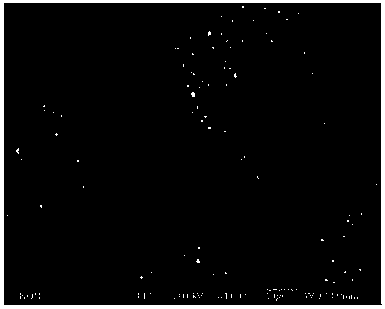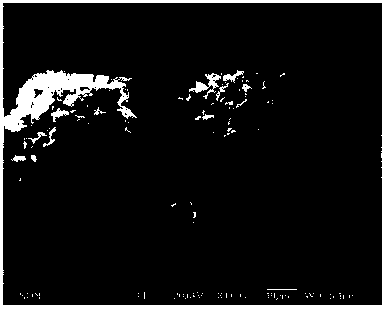Preparation method of rear earth europium doped hollow nano TiO2 glass micro beads
A hollow glass microbead and nanotechnology, applied in chemical instruments and methods, metal/metal oxide/metal hydroxide catalysts, physical/chemical process catalysts, etc., can solve the problem of lack of photocatalytic layer, and achieve easy operation. , save raw materials, increase the effect of specific surface area
- Summary
- Abstract
- Description
- Claims
- Application Information
AI Technical Summary
Problems solved by technology
Method used
Image
Examples
Embodiment 1
[0104]Weigh 10g of hollow glass microspheres, add them to 1L of tap water at 40°C, stir at 100rpm for 5min, then raise the temperature of tap water to 70°C, soak at constant temperature for 1h, let it stand until it cools down to room temperature naturally, After the hollow glass microspheres are stratified, remove the hollow glass microspheres floating on the upper surface of the tap water, and rinse with tap water once to complete the flotation and cleaning of the hollow glass microspheres to obtain clean hollow glass microspheres. ;Add 10g of sodium hydroxide to 1L of deionized water to prepare a sodium hydroxide solution with a mass concentration of 10g / L; take the flotation clean hollow glass beads and add them to a temperature of 40°C and a mass concentration of 10g / L In the sodium hydroxide solution, stir the hollow glass microspheres in the sodium hydroxide solution at a rate of 100rpm for 10min, then fish out the hollow glass microspheres, and wash the taken out hollow...
Embodiment 2
[0111] Weigh 20g of hollow glass microspheres, add them to 1L of tap water at 70°C, stir at 200rpm for 10min, then raise the temperature of tap water to 90°C, soak at constant temperature for 1h, let it stand until it cools down to room temperature naturally, After the hollow glass microspheres are stratified, remove the hollow glass microspheres floating on the upper surface of the tap water, and rinse with tap water for 3 times to complete the flotation and cleaning of the hollow glass microspheres to obtain clean hollow glass microspheres. ;Add 20g of sodium hydroxide to 1L of deionized water to prepare a sodium hydroxide solution with a mass concentration of 20g / L; take clean hollow glass microspheres and add them to a temperature of 80°C and a mass concentration of 10g / L sodium hydroxide In the solution, stir and process the hollow glass microspheres in the sodium hydroxide solution for 30min at a rate of 200rpm, then fish out the hollow glass microspheres, wash the taken ...
Embodiment 3
[0118] Weigh 15g of hollow glass microspheres, add them to 1L of tap water at 45°C, stir at 150rpm for 7min, then raise the temperature of tap water to 80°C, soak at constant temperature for 1h, let it stand until it cools down to room temperature naturally, After the hollow glass microspheres are stratified, remove the hollow glass microspheres floating on the upper surface of the tap water, and rinse them twice with tap water to complete the flotation and cleaning of the hollow glass microspheres, and obtain clean hollow glass microspheres. ;Add 15g of sodium hydroxide to 1L of deionized water to prepare a sodium hydroxide solution with a mass concentration of 15g / L; take the flotation clean hollow glass beads and add them to a temperature of 60°C and a mass concentration of 15g / L In the sodium hydroxide solution, stir the hollow glass microspheres in the sodium hydroxide solution at a rate of 150rpm for 20min, then take out the hollow glass microspheres, and wash the taken o...
PUM
| Property | Measurement | Unit |
|---|---|---|
| particle size | aaaaa | aaaaa |
Abstract
Description
Claims
Application Information
 Login to View More
Login to View More - R&D
- Intellectual Property
- Life Sciences
- Materials
- Tech Scout
- Unparalleled Data Quality
- Higher Quality Content
- 60% Fewer Hallucinations
Browse by: Latest US Patents, China's latest patents, Technical Efficacy Thesaurus, Application Domain, Technology Topic, Popular Technical Reports.
© 2025 PatSnap. All rights reserved.Legal|Privacy policy|Modern Slavery Act Transparency Statement|Sitemap|About US| Contact US: help@patsnap.com



